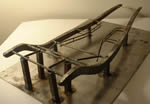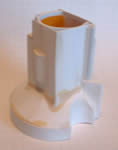|
Last Updated: Aug 16th, 2006 - 11:01:00 |

Transportation design seems to be the major endeavor for the automotive youth in this day in time. People see shows on TV depicting people building choppers, cars, and other custom vehicles with complete ease. Then these same viewers think they can do the same. Quite contrary to first impression, it is a tremendous task to build a custom auto using existing plans, much less build one from scratch. Nobody sees the behind the scenes. All they show on TV is the interesting stuff, people welding a few things, making a few drawings, using loads of body filler, and painting the final product. Have you ever wondered how that product got there? Nobody went out and just said, "Today I think I will build a hot rod". There are literally thousands of hours of design put into these projects that is never shown to the public.
Hot rods have always been an underground hit, much like automotive tuners. Both worlds have their designers. People can design a car, but will it work? People in foreign countries have always designed cars for aesthetics and attempted to blend them into the environment, however current cars are designed around a person - personally, I design a vehicle around two things: Is it drivable? And equally as important, will it win design awards at auto shows? I decided to push the envelope of the hot rod design world and design a scratch built street rod. A large majority of the hot rod world uses preexisting cars, bodies, frames, etc. But once you reach a certain point of redesign on an existing template; there have so many things changed, it is pretty much a scratch built vehicle.
|      | Being that my design would be scratch build from the start, I decided I would make a model of what would soon be the real thing. The major start of this tremendous task began in March of 2004. The first stage of the intricate process was the design itself. It all starts out as an idea, a mental picture, just a few shapes and thoughts. Soon, those thoughts are transferred onto paper as quick, rough, sketchy inked lines. This single sketch is one of what will become small library of conceptualizations and form the base of the whole project. To other people, this sketch would look like a messy idea for a car, for me I see the drawing differently; I see definite flowing lines and shapes, all small portions of a greater work of art. From that first sketch I will toss around ideas and design concepts in my head. A lot of these thoughts just come to me at a random time, watching TV, doing homework, listening to music, and even in the middle of the night. Often times I have to immediately stop what I'm doing and sketch it out. After about fifty or so sketches, all detailing one portion of the vehicle, they are all laid out and compiled into one design. That one final design will change and grow as the design and fabrication continues.
I don't abide by the dictum of form following function. My approach is the opposite, function follows form. What's the point of the hot rod if it doesn't look good? The challenge is making a design that looks good, and works well. As stubborn as I am I am not going to sacrifice cosmetic design for the ease of mechanical functionality. I'll overcome the obstacles. Being the top dog in this world is all about making the sketches of good designs work. Not making something ugly that works well. When the appearance of the rod is determined first, there is more room to invent a unique quality overall design. We are no longer bound by function to determine the design criteria. This will become readily apparent later.
  
| The tedious and tricky process is getting all the different design elements to harmonize and to do it well. Once again it starts as thoughts. Then these ideas are thoroughly visualized and sketched out onto paper. Thousands of thoughts plus hundreds of sketches are brought together to form one complete design. Thought after thought, sketch after sketch, draft after draft, after hours of creating concepts the finalized design will start to come together. The hardest part is designing not only something that will work, but something that will work well in all aspects. It may function mechanically, but it won't have the right look, or it may be beautiful but not perform. The design phase is all about finding the perfect balance of unity between form and function, and unfortunately that final design sometimes requires minor alteration of the original look. If I can't see any other way around a functioning design I will go back to the drawing board and keep sketching out ideas. Lastly, if I must alter the look of the original plan, then I will concede to making minor alterations.
At this point it is nearing June and roughly 500 hours of design have been logged. The main piece, the frame, is nearing the end of the design stages. Soon the beginning of the frame fabrication will start as design elsewhere continues. Something to keep in mind throughout the design process is to have an idea of what materials you have access to, or what is needed. Each material has its own unique use and ability. The frame, the basic platform for the entire vehicle, has to be strong and functional. This is one of the hardest parts to design. This one piece is the foundation for the whole design. If it fails, everything fails. This piece requires much more than drawing lines. These sketches are often detailed sketches with lots of trigonometry and geometry involved. Although there are no moving parts, this is the most functional piece, yet it is designed within the aesthetics of the entire design. If the car needs to be low, then I have to design a frame that sits low, so that it doesn't interrupt the design of the body of the car, and I have to also make sure it is safe to drive.
| After about 850 hours of design, about 135 hours of fabrication, and $175+ spent on consumables and parts the hot rod starts to come alive. Even though the current project is only a model for the real thing, it involves a lot more than can be imagined. A lot of times I will design something, then fabricate it, and something won't work due to unforeseen circumstances. This is why I build models first, it is infinitely better to mess something up on a model than the real thing. Also it is important to keep in mind that with all the different design concepts, it becomes necessary to prototype the prototype.
 
After nearly five months, there isn't much to show. Basically 1000 hours of design, 175 hours of fabrication, and $300+ spent, and all I have is about half a frame built and books full of sketches. I have spent hours upon hours on trigonometry and geometry calculations, it's all a part of the game. This just illustrates for everyone who wants to be a designer/fabricator what all is involved. It is not nearly as easy as welding a couple pieces of metal together and calling it a hot rod. There is an immeasurable amount of time spent in just the design phases of a custom hot rod. Hopefully this article has conveyed just how much effort is required to properly piece together a true custom auto and gives a good starting point for those who are interested in pursuing this art form.
Check out the existing thread on AutomotiveForums.com covering this hot rod build.
Discuss this article on AutomotiveForums.com
© Copyright 2006 by AutomotiveArticles.com
Top of Page
|

 AF Project Vehicle | Corporate
AF Project Vehicle | Corporate



 AF Project Vehicle | Corporate
AF Project Vehicle | Corporate

